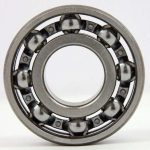Tight and Loose Fits for Radial Ball Bearings
Selecting appropriate shaft and housing tightness fits are critical in optimizing a radial ball bearing’s performance and life. A bearing can only perform to its full capacity when it is correctly fitted on the shaft and in the housing. Improper fits can lead to undesirable operating conditions and early failure.

The most common considerations:
- Direction, type, and magnitude of loads - Based on the actual applied axial and radial loads an equivalent radial load is calculated. Generally, tighter fits are required as the load increases. Further, rings subjected to circumferential loading should have tight fits. For rings subjected to only point loading, a loose fit may be used.
- Inner or outer ring rotation - Typically, the ring that is rotating requires an interference fit, and the non-rotating ring would have a slightly loose fit.
- The size and type of bearing specified - Thin type and miniature bearings are very sensitive to interference fits due to loss of radial play. Bearings with heavier cross sections generally require tighter fits.
- Material and manufacturing tolerances of mating components - Fit tolerances are based on cast iron or steel housings and shafts. For alloys such as aluminum (with a different modulus of elasticity), a tighter fit is required to achieve rigid seating.
- Operating temperature - With tight fits and a temperature differential between the inner and outer ring, the radial internal clearance in the bearing is reduced. This must be taken into consideration when selecting the internal clearance. Additionally, if the materials used for the housing or shaft are dissimilar, they will have different coefficients of thermal expansion than the bearing rings. This must be taken into consideration to achieve rigid seating.
- Running accuracy required - In order to achieve high running accuracy, the same high standard of accuracy and surface quality expected in the bearing must be applied to the shaft and housing as well. In addition, with miniature and thin type bearings irregularities on the shaft or in the housing are transferred to the relatively thin walled bearing rings.
Want to learn more about radial ball bearings and the factors that can extend or shorten their operating lives? Try AST’s new calculator, click here.
If you need assistance with understanding radial ball bearings fits, our team of bearing experts are standing by to provide engineering consulting and design, contact them here.

